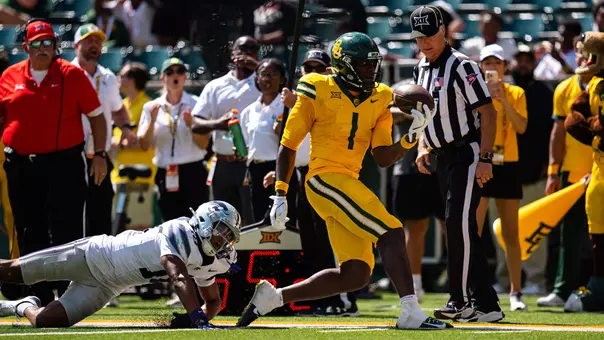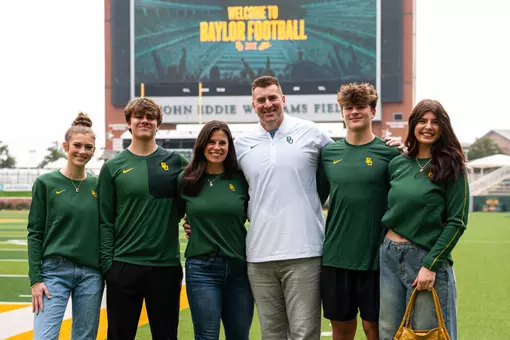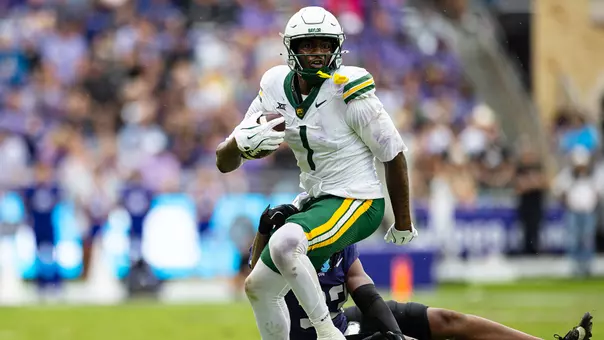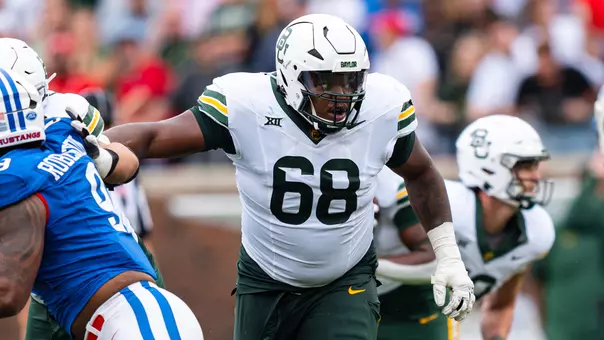Dave Campbell's Insider Notepad -- 4/25/01
4/25/2001 12:00:00 AM | Football
April 25, 2001
Editor's Note: Dave Campbell's column appears in each edition of the Baylor Bear Insider Report, available upon membership in the Baylor Bear Foundation. For information on joining the Bear Foundation, click here. For an archive of his other columns, click here.
As the afternoon shadows lengthened and the crowd grew silent on that fateful November afternoon, as the clock at Waco's old Municipal Stadium remained motionless in breathless anticipation, a solitary Baylor Bear left the sideline and limped onto the playing field -- a wounded warrior given a last-second opportunity to grab a lasting taste of glory for himself and his team.
And Jack Wilson seized the moment.
The Baylor Bears, coached by Frank Kimbrough, had just scored a touchdown with something like 18 seconds remaining in the fourth quarter. They needed a successful extra point kick to tie mighty Texas.
Jack Wilson kicked that extra point, the Bears tied Texas, 7-7, and one World War, three Baylor coaches and 15 years later, that 7-7 tie was voted "the greatest upset in the first 40 years of the Southwest Conference." Yes, a tie was a monumental upset.
Jack William Wilson died last week at the age of 83, at his longtime home in Waco, and for many an oldtime Baylor football fan the memories came rushing back. They centered, of course, on that remarkable game the Bears played against Texas on Nov. 8, 1941, but there was so much more to the Jack Wilson story than that.
He might have been as gifted an athlete as Baylor has ever enrolled, and yes, I know the Bears have been blessed with the likes of such extraordinary athletes over the years as Del Shofner and Larry Isbell and Jerry Mallett, Billy Patterson and Ted Lyons and Ronnie Goodwin. I could name at least a dozen more, wearers of the green and gold who excelled in multiple sports.
JACK WILSON COULD have excelled in just about any sport he tried.
A native of Sumner, Texas, and recruited by Baylor from Paris Junior College, he won the Southwest Conference shot put crown in 1940 and again in '42. He was a starting guard on Bill Henderson's 1941 and '42 basketball teams. He ran the quarter mile for the track team, and he did it all -- run, pass, catch, punt, play defense -- for the football team as the starting tailback. You can look it up: he still holds the record for the second longest punt in Baylor football history -- 89 yards against Rice on Nov. 30, 1940.
"He was absolutely the best athlete I ever saw," one of Wilson's 1941 teammates, guard Al Dewlen, was saying last week. "Absolutely the Greek-God type. Beautiful muscle development. You can look in the 1942 Baylor Yearbook. There's a picture of Jack in there, throwing the shot. And the caption reads, 'Baylor's Mr. Muscles.'
"Jack didn't play golf in those days, had never tried golf. One day several of the guys talked him into giving it a try. They went out to a golf course, teed up the ball for him for his first drive -- and he hit it almost out of sight, over 400 yards."
(Jack Wilson's son, Bobby, has won wide recognition in the last decade or so as one of golf's greatest long-drive specialists. It must be the genes.)
Dewlen also said: "I remember eating with some of the guys one day -- Jack Russell, a fantastic end for Baylor in those days, was one of them -- and I remember Russell telling us, 'Well, ol' Tarzan will be here in a minute.' And in a minute, sure enough, here came Jack Wilson. When you saw what a body he had, you knew what they were talking about."
WILSON SERVED WITH the U.S. Army in the Pacific in World War II, and when he returned home he became a first-round draft choice of the Chicago Bears. He was that good.
"I was in the Marines and Jack was in the Army in World War II, and I remember seeing him on Bougainville just before we shipped out for action in the Philippines," recalled Dewlen. "The Army guys had moved in behind us on Bougainville, and after they got ashore they had some sergeant putting the troops through calisthenics. When I looked more closely, I saw it was Jack Wilson. We had a good visit before I left."
This writer remembers a conversation a number of years ago with Noble Doss, a remarkable pass receiver on those 1940-41 Texas teams, and in the course of the conversation the name of Jack Wilson came up. "I believe Jack Wilson had the finest physique of any athlete I ever saw," said Doss.
The only problem was, Wilson didn't have the luck to match the physique. Only injuries could have kept him from being remembered among Baylor's all-time great gridders.
THE 1941 SEASON provides a good example. Rookie coach Frank Kimbrough's Bears were expected to be a highly competitive team in the SWC that year. They had Wilson at tailback, Bill Coleman in the backfield with him, the destructive Russell at end, Buddy Gatewood at center/linebacker and Bubo Barnett at tackle. Wilson's main backup at tailback was a slippery little jack-of-all-trades named Kit Kittrell who had been a high school sensation at nearby McGregor.
The Bears began that season by defeating Hardin-Simmons and then it was off to the Rocky Mountains by train to play U. of Denver. The Bears won that game, 14-7, but Wilson did not return with the team. He stayed behind in a Denver hospital with a ruptured kidney.
That injury took a lot of wind out of Baylor's sails.
With their main backfield taw out of action, the Bears somehow managed to beat Arkansas in Waco but then lost to Villanova in Philadelphia. And then, horror of horrors, they lost to Texas A&M at College Station by the embarrassing score of 48-0. That was the worst beating suffered by the Bears at the hands of the Aggies since 1912 (before the SWC was formed) when A&M planted a 53-0 trouncing on the Bears. And even today, 59 years after the fact, that 48-0 mauling remains Baylor's second worst defeat in an A&M rivalry that goes back to 1899.
Having lost to the Aggies by such a top-heavy score, the Bears returned home and lost to TCU by a less ghastly score of 23-12.
By then the Bears were 3-3 in the record book but they had lost three straight games by a combined score of 85 to 18 and nobody was referring to them as a good team. Or even a pretty good team. And by then Jack Wilson was hobbled by a bad ankle.
AND COMING UP NEXT on their schedule was a super team.
Longhorn coach D.X. Bible had been building methodically and carefully since 1937, each season raking in many of the top prospects in the state (sound familiar?). When the 1941 season began, Bible was ready. His Longhorns were armed to the teeth. Even their second team could have made quite a splash that season.
They began the season by mauling Colorado, 34-6, and then smeared LSU, 34-0. Oklahoma fell next, 40-0. Then it was Arkansas' time, 48-14. Rice got trounced, 40-0. And SMU, 34-0. Those were runaway victories. Teams in those days didn't score points the way they do now.
UT having plundered SMU in Dallas by such a convincing score, voters in the Associated Press poll pronounced Texas the No. 1 team in the country, far ahead of Minnesota in the balloting, and Life Magazine revealed it was turning over its cover to the Longhorns for its Nov. 17 issue and was devoting an 8-page spread to D.X.'s wonder boys who had just been pronounced "the greatest team in Southwest Conference history, yes, even better than my 1935 Rose Bowl team" by SMU coach Matty Bell.
When the Longhorns trooped into their Hill Hall dining room after larruping SMU, they found their their venerable housemother, Mrs. J.M. "Miz Griff" Griffith, had left a long-stemmed red rose by each plate.
"This is for the Rose Bowl because that is where you're going," she told the players.
IS IT ANY WONDER that Texas was favored to whip Baylor in a manner unfit for the eyes of sheltered women and small children? Jinx Tucker, who had been sports editor of the Waco Tribune-Herald since the days of Woodrow Wilson in the White House, thought the score probably would get out of hand but he didn't want to dishearten Frank Kimbrough's team. So he picked Texas only to win by a score of 50-0, and then he went off to College Station to see "a good game," SMU vs. A&M.
He missed a game for the ages.
Texas failed to make a first down in the opening quarter as Baylor fans in the crowd of 12,000 thrilled to the action. Just before halftime, Baylor screwed up a punt, enabling the Longhorns to take possession at the BU 10-yard line. Three plays later the Longhorns had the lead, 7-0.
It stayed that way all through the third period. Once Baylor marched the ball to the UT 6-yard line and failed to score, and Texas marched back to the Baylor 11 and ran out of downs. A little later the injured Doss got open for an apparent 45-yard touchdown catch, but dropped the pass at the goal line.
With 4 minutes left in the game, Baylor gained possession on its own 18-yard line.
BY THEN THE BEARS were worn down but full of heart. And perhaps they could still hear ringing in their ears the words of the poem Kimbrough had read to them before the opening kickoff. The poem was that old Edgar Guest favorite, It can be done. "Somebody said that it couldn't be done, but he with a chuckle replied that maybe it couldn't, but he would be one who wouldn't say so till he'd tried. . ."
Indeed, Bible had read that same poem to his Longhorns before sending them out to upset A&M's undefeated, untied, defending national champions in 1940, thus knocking them out of the Rose Bowl.
Another thing, as Dewlen recalls, "Frank Kimbrough and his coaches had noticed that when teams dropped back to pass, Texas' great guard Chal Daniel (All-America in '41), who was very fast, would drop back out of the line to cover the short pass over the middle. So Kimbrough had Kittrell fake a pass, then run up the middle where Daniel had been. We made yardage on that play all afternoon."
Running out of time, staring defeat in the face, the Bears began at their own 18 and started piling up yards and first downs. They got to the Texas 27, and at that point Kittrell fumbled. But the ball rolled forward and guard Louis Self recovered for the Bears at the UT 21. Another play gained them a first down at the 19.
But now less than 30 seconds remained to play. Kittrell dropped back to pass and threw incomplete.
Again he dropped back, and waited and waited, escaping Longhorn tacklers, and then he threw into the Texas end zone -- and little Bill Coleman, on his knees, was there to catch the touchdown pass.
WOULD THE BEARS now get that one point they needed to secure the tie? A hushed stadium waited. Jack Wilson, bum ankle and all, limped out to try the kick, and his kick was true, and then the game was over and jubilation reigned in Baylor ranks. The Bears actually had tied the "unbeatable" Texas Longhorns, and the word is that when Jinx Tucker first heard the score as relayed to him in the A&M press box he refused to believe it.
And they do say one of the toughest of all the Longhorns, end coach Blair Cherry, who later would succeed Bible as head coach, broke down and sobbed. And, no, Texas never did get to the Rose Bowl.
But there was only laughter on the Baylor side of the field late that afternoon, and Jack Wilson wore one of the widest smiles of all. Years later, after I inherited the Baylor football beat, our paths crossed many times. By then Jack was defensive backfield coach on George Sauer's staff, and also the Baylor track coach for several years. He still had a ready smile and he still had those muscles, and yes, if you asked him, he still had an indelible memory of a golden moment in Baylor's football history, a moment that will live forever.
Editor's Note: Dave Campbell's column appears in each edition of the Baylor Bear Insider Report, available upon membership in the Baylor Bear Foundation. For information on joining the Bear Foundation, click here. For an archive of his other columns, click here.



















